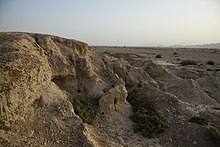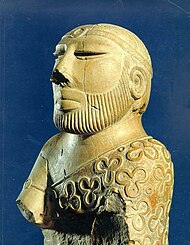Mehrgarh
Early Harappan period |
Mehrgarh is a
History
Mehrgarh is the earliest known site in South Asia showing evidence of farming and herding.[5][6][note 1] It was influenced by the Neolithic culture of the Near East,[16] with similarities between "domesticated wheat varieties, early phases of farming, pottery, other archaeological artefacts, some domesticated plants and herd animals."[17][note 2] According to Asko Parpola, the culture migrated into the Indus Valley and became the Indus Valley Civilisation of the Bronze Age.[18]
Jean-Francois Jarrige argues for an independent origin of Mehrgarh. Jarrige notes "the assumption that farming economy was introduced full-fledged from Near-East to South Asia,"[19][note 2] and the similarities between Neolithic sites from eastern Mesopotamia and the western Indus Valley, which are evidence of a "cultural continuum" between those sites. However, given the originality of Mehrgarh, Jarrige concludes that Mehrgarh has an earlier local background," and is not a "'backwater' of the Neolithic culture of the Near East."[19]

Lukacs and Hemphill suggest an initial local development of Mehrgarh, with continuity in cultural development but a population change.[35] According to Lukacs and Hemphill, while there is a strong continuity between the Neolithic and Chalcolithic cultures of Mehrgarh, dental evidence shows that the Chalcolithic population did not descend from the Neolithic population of Mehrgarh,[36] which "suggests moderate levels of gene flow."[36] They wrote that "the direct lineal descendants of the Neolithic inhabitants of Mehrgarh are to be found to the south and the east of Mehrgarh, Pakistan in northwestern India and the western edge of the Deccan Plateau," with Neolithic Mehrgarh showing greater affinity with Chalcolithic Inamgaon, south of Mehrgarh, than with Chalcolithic Mehrgarh.[36][note 3]
Gallego Romero et al. (2011) state that their research on lactose tolerance in India suggests that "the west Eurasian genetic contribution identified by Reich et al. (2009) principally reflects gene flow from Pakistan, Iran and the Middle East."[39] Gallego Romero notes that Indians who are lactose-tolerant show a genetic pattern regarding this tolerance which is "characteristic of the common European mutation."[40] According to Romero, this suggests that "the most common lactose tolerance mutation made a two-way migration out of the Middle East less than 10,000 years ago. While the mutation spread across Europe, another explorer must have brought the mutation eastward to India – likely traveling along the coast of the Persian Gulf where other pockets of the same mutation have been found."[40] They further note that "[t]he earliest evidence of cattle herding in south Asia comes from the Indus River Valley site of Mehrgarh and is dated to 7,000 YBP."[39][note 4]
Periods of occupation
Archaeologists divide the occupation at the site into eight periods.
Mehrgarh Period I (pre-7000–5500 BCE)
The Mehrgarh Period I (pre-7000–5500 BCE)
Periods I, II, and III are considered contemporaneous with another site called Kili Gul Mohammad.[43] The aceramic Neolithic phase in the region had originally been called the Kili Gul Muhammad phase. While the Kili Gul Muhammad site itself probably started c. 5500 BCE, subsequent discoveries allowed the date range of 7000–5000 BCE to be defined for this aceramic Neolithic phase.[44]
In 2001, archaeologists studying the remains of nine men from Mehrgarh discovered that the people of this civilization knew proto-dentistry. In April 2006, it was announced in the scientific journal Nature that the oldest (and first early Neolithic) evidence for the drilling of human teeth in vivo (i.e. in a living person) was found in Mehrgarh. According to the authors, their discoveries point to a tradition of proto-dentistry in the early farming cultures of that region. "Here we describe eleven drilled molar crowns from nine adults discovered in a Neolithic graveyard in Pakistan that dates from 7,500 to 9,000 years ago. These findings provide evidence for a long tradition of a type of proto-dentistry in early farming culture."[45]
Mehrgarh Period II (5500–4800 BCE) and Period III (4800–3500 BCE)
The Mehrgarh Period II (
Period III was not much explored, but it was found that Togau phase (c. 4000–3500 BCE) was part of this level, covering around 100 hectares in the areas MR.2, MR.4, MR.5 and MR.6, encompassing ruins, burial and dumping grounds, but archaeologist Jean-François Jarrige concluded that "such wide extension was not due to contemporaneous occupation, but rather due to the shift and partial superimposition in time of several villages or settlement clusters across a span of several centuries."[47]
Togau phase
At the beginning of Mehrgarh III, Togau ceramics appeared at the site. Togau ware was first defined by
Togau ceramics are decorated with geometric designs and were already being made with a potter's wheel.
Mehrgarh Period III, during the second half of the 4th millennium BCE, is characterized by important new developments. There is a big increase in the number of settlements in the Quetta Valley, the Surab Region, the Kachhi Plain and elsewhere in the area. Kili Ghul Mohammad (II−III) pottery is similar to Togau Ware.[49]
Mehrgarh Periods IV, V and VI (3500–3000 BCE)
Period IV was 3500–3250 BCE, Period V from 3250–3000 BCE, and Period VI was around 3000 BCE.[50] The site containing Periods IV to VII is designated as MR1.[46]
Mehrgarh Period VII (2600–2000 BCE)
Sometime between 2600 BCE and 2000 BCE, the city seems to have been largely abandoned in favor of the larger fortified town
Archaeologist Massimo Vidale considers a series of semi-columns found in a structure at Mehrgarh, dated around 2500 BCE by the French mission there, to be very similar to semi-columns found in Period IV at Shahr-e Sukhteh.[52]: min.12:10
Mehrgarh Period VIII
The last period is found at the Sibri cemetery, about 8 kilometers from Mehrgarh.[46]
Lifestyle and technology
Early Mehrgarh residents lived in
The oldest known example of the lost-wax technique comes from a 6,000-year-old wheel-shaped copper amulet found at Mehrgarh. The amulet was made from unalloyed copper, an unusual innovation that was later abandoned.[55]
Artifacts

Human figurines
The oldest ceramic figurines in South Asia were also found at Mehrgarh. They occur in all phases of the settlement and were prevalent even before pottery appears. The earliest figurines are quite simple and do not show intricate features. However, they grow in sophistication with time, and by 4000 BCE begins to show their characteristic hairstyles and typical prominent
Pottery

Evidence of pottery begins from Period II. In Period III, the finds become much more abundant as the
Burials
There are two types of burials in the Mehrgarh site. There were individual burials where a single individual was enclosed in narrow mud walls and collective burials with thin mud-brick walls within which skeletons of six different individuals were discovered. The bodies in the collective burials were kept in a flexed position and were laid east to west. Child bones were found in large jars or urn burials (4000–3300 BCE).[62]
Metallurgy
Metal findings have been dated as early as Period IIB, with a few copper items.[46][61]
See also
| History of Pakistan |
|---|
 |
| Timeline |
| The Neolithic |
|---|
| ↑ Mesolithic |
| ↓ Chalcolithic |
| History of South Asia | |
|---|---|
 | |
| (330–323 BC) | |
| Maurya Empire | (321–184 BC) |
| Seleucid India | (312–303 BC) |
| Sangam period | (c. 600 BC – c. 300 AD) |
| Pandya Empire | (c. 300 BC – AD 1345) |
| Chera Kingdom | (c. 300 BC – AD 1102) |
| Chola Empire | (c. 300 BC – AD 1279) |
| Pallava Empire | (c. 250 AD – AD 800) |
| Maha-Megha-Vahana Empire | (c. 250 BC – c. AD 500) |
| Parthian Empire | (247 BC – AD 224) |
